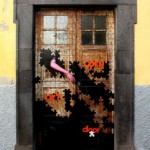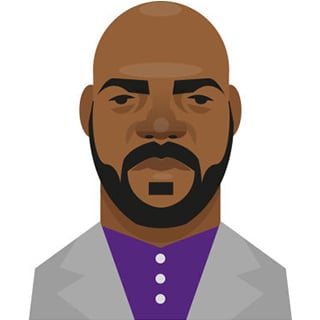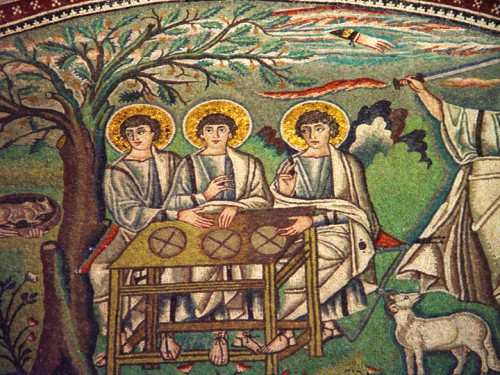 Genesis 1, the beautiful hymn to Imago Dei, the One God, opens the Bible by casting away an uproar of deities without naming any of them, describing instead the panoply of God’s Creation in days and nights. This Imago Dei is the great gift to which Judaism and Christianity belong. The One God: not pulling the sun across the sky in a chariot, nor lording the creatures of the dark into a nether world, but raising all, in days that begin when the sun goes down, from chaos to life.
Genesis 1, the beautiful hymn to Imago Dei, the One God, opens the Bible by casting away an uproar of deities without naming any of them, describing instead the panoply of God’s Creation in days and nights. This Imago Dei is the great gift to which Judaism and Christianity belong. The One God: not pulling the sun across the sky in a chariot, nor lording the creatures of the dark into a nether world, but raising all, in days that begin when the sun goes down, from chaos to life.
Why, then, the Trinity?
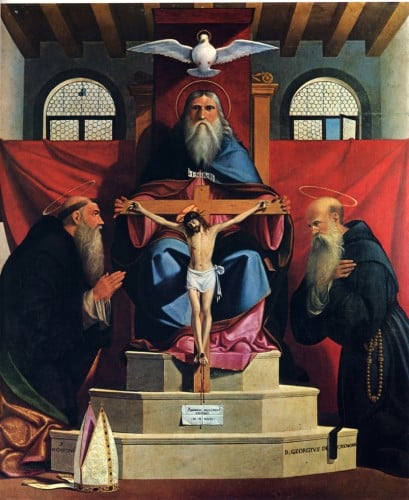 Jesus never said the word. Would he himself have shrunk away from this name, as from a blasphemy?
Jesus never said the word. Would he himself have shrunk away from this name, as from a blasphemy?
Alas, the Name of Trinity has been used for evil, as a righteous boot to bring the defiantly different to their knees, as an act of submission required from Jews who would teach in universities or practice medicine in hospitals, or from women who were threatened with death by fire as witches, and even at baptisms where it was thought to cast out demons from children.
More mundanely, it has been turned into a pledge of allegiance, salted throughout the liturgies of Christian worship, sorting Christians from each other as well as from all the peoples of this world whose imago dei is not invoked by these names.
And Yet:
The fire of Trinity does still light ways in the wilderness with its image of inclusive relationship: a Maker from whom all life rises; a Son whose many images (Babe, Wise Child, Rabbi, Beloved, Healer, Party Goer, Forgiving , Suffering, Fallen and Risen One) embrace all that is lost in us; and the Spirit, by whose enlightenment we all become the imago dei of the Maker and the Son.
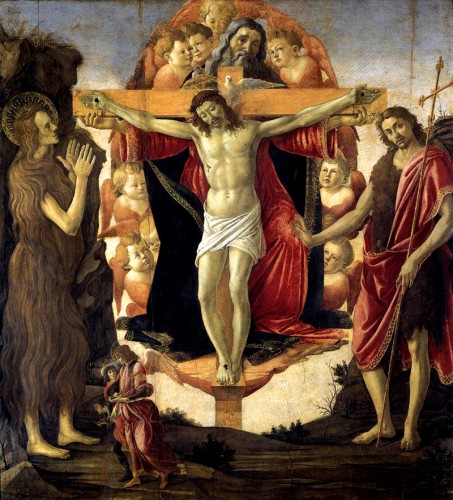 In Trinity the energy flows in all directions. Within Trinity is the good green pasture which is home: the place where we are safe, where the table is full and quiet waters flow. Here is the Holy City of God, where the Tree with leaves that heal nations drinks from the waters of four rivers, and where God is the light of all people.
In Trinity the energy flows in all directions. Within Trinity is the good green pasture which is home: the place where we are safe, where the table is full and quiet waters flow. Here is the Holy City of God, where the Tree with leaves that heal nations drinks from the waters of four rivers, and where God is the light of all people.
St. Patrick spoke of Trinity in simple ways (three kinds of water: dew, rain and ice) and grand words:
I bind unto myself today the strong name of the Trinity, by Invocation of the same, the Three in One, the One in Three. I bind unto myself today, the virtues of the starlit heaven, the glorious sun’s life-giving ray, the whiteness of the moon at even, the flashing of the lightning free, the whirling wind’s tempestuous shocks, the stable earth, the deep salt sea, around the old appointed rocks. Christ beneath me, Christ above me, Christ in quiet, Christ in danger, Christ in hearts of all that love me, Christ in mouth of friend and stranger. (words from St. Patrick’s Breastplate)
Emily Dickinson wrote her own Trinity: In the name of the Bee, and the Butterfly, and the Breeze – Amen! In them she has caught an image for the Maker, the Christ, and the Spirit, without a transcendant descent. All live in, sanctify, and are vulnerable to this world.
Kris Kristofferson, Oxford Rhodes scholar and country western singer, writes softly after years of deep pain: Life is the question and life is the answer, God is the reason and Love is the Way. His experience of Trinity begins with the Spirit, then moves to God, and finally to Love.
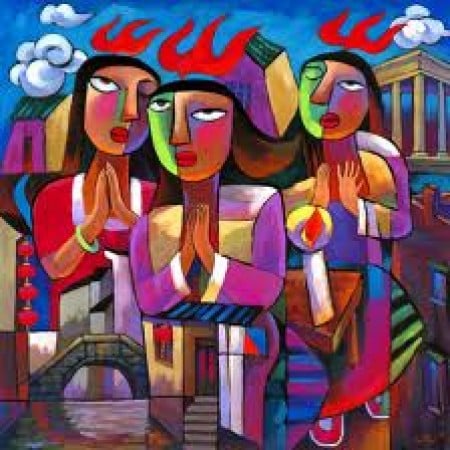 Threeness permeates our thinking:
Threeness permeates our thinking:
morning, noon and night;
knife, fork and spoon;
father, mother, child;
sun, moon, and stars;
beginning, middle, end;
over, under, through;
win, lose, or draw;
take, give, share
reading, writing, ‘rithmetic . . .
you can fill pages with things that take their meaning from each other in threes, and describe a fullness, mundane or holy.
Like these, Trinity means to make connection, to overcome separation, to join what has been declared insignificant – to find, in the image of one, the others – an image that is all and also far beyond any.
It is our fall to see in the Trinity image any thing less than all.
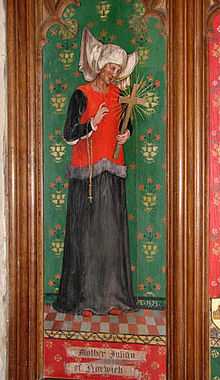 Julian of Norwich, 12th c. English mystic and survivor of the Black Death, wrote this of the Trinity:
Julian of Norwich, 12th c. English mystic and survivor of the Black Death, wrote this of the Trinity:
I saw no difference between God and our substance, but, as it were, all God; and still my understanding accepted that our substance is in God, that is to say that God is God, and our substance is a creature in God. For the almighty truth of the Trinity is our Father, for he made us and keeps us in him. And the deep wisdom of the Trinity is our Mother, in whom we are enclosed. And the high goodness of the Trinity is our Lord, and in him we are enclosed and he in us. We are enclosed in the Father, and we are enclosed in the Son, and we are enclosed in the Holy Spirit. And the Father is enclosed in us, the Son is enclosed in us, and the Holy Spirit is enclosed in us, almighty, all wisdom and all goodness, one God, one Lord.
John wrote that Jesus said, I still have many things to say to you, but you cannot bear them now. (John 16:12)
Trinity Sunday, then, is a day for experiencing the world through wonder, and acknowledging that the end of the story is still unknown, as are the still–unfolding and unimaginable names of God. And that all of them are part of the holy and indivisible One.
__________________________________________
Illustrations:
1. Abraham and Three Angels, 521-27, Basilica di San Vitale, Ravenna, Italy. Vanderbilt Divinity School Library, Art in the Christian Tradition.
2. Trinity with Worshippers, 1517, Santa Maria della Consolazione, Andrea Previtali.Vanderbilt Divinity School Library, Art in the Christian Tradition.
3. Trinity with Magdalene, John the Baptist . . . Sandreo Botticelli, 1491, Courtauld Institute, London. Vanderbilt Divinity School Library, Art in the Christian Tradition.
4. The Fires of Pentecost, He Qi, Chinese Artist, Nanking. Vanderbilt Divinity School Library, Art in the Christian Tradition.
5. Julian of Norwich, her image present in The Church of Saints Andrew and Mary, Norwich, England. Wikipedia page image for Julian of Norwich.



